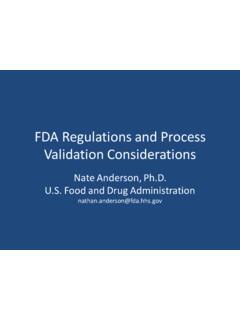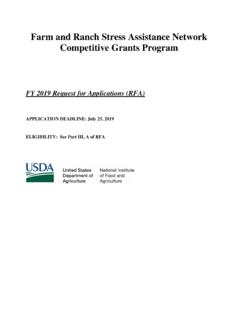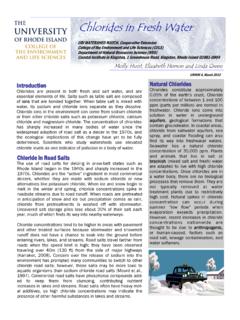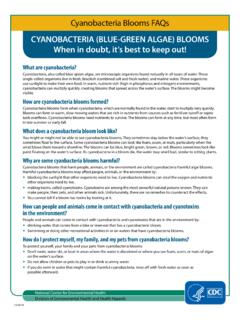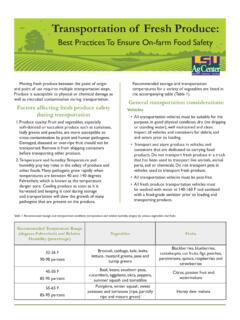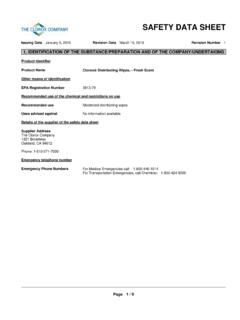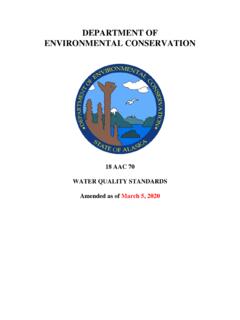Transcription of Guide to Washing Fresh Produce - National Institute of ...
1 Fact Sheet No. Food and Nutrition Series|Food Safetyby A. Zander and M. Bunning* Fresh Produce can harbor bacteria, fungi, and other microbes along with trace amounts of chemicals. Fortunately, there are steps you can take to help improve the safety of fruits and vegetables. Steps to Limiting Bacterial Contaminants and Pesticides Start clean. Cleanliness and safe Produce go hand in hand. Before preparing fruits and vegetables, always wash your hands well with soap and water . Clean counter tops, cutting boards, and utensils with hot soapy water before peeling or cutting Produce . Bacteria from the outside of raw Produce can be transferred to the inside when it is being cut or peeled. Buy local. Reducing transport time and distance can help limit the chances of contamination and bacterial growth. Produce that needs to be refrigerated at home should also be kept cool at the market. Cut melon and salad greens should be kept on ice at the market Limit quantities. Most Fresh vegetables can only be stored for two to five days, although apples, onions, potatoes, and winter squash can last much longer at appropriate temperatures.
2 Wait to wash. Washing Produce before storing may promote bacterial growth and speed up spoilage, so it is often recommended to wait and wash fruits and vegetables just before use. Generally, soil has been removed from Fresh Produce but if not and you chose to wash before storing, dry thoroughly with clean paper towels before storing. Store safely. Produce that requires refrigeration can be stored in vegetable bins or on shelves above raw meats, poultry, or seafood to prevent cross contamination. Storing Fresh Produce in cloth Produce bags Quick Facts Fresh fruits and vegetables are an important and flavorful part of a healthful diet. Types of Fresh Produce vary widely, from root vegetables to delicate berries, and recommended methods of Washing depend on the type and characteristics of the Produce . To ensure Produce safety and quality, consumers should handle and wash Produce properly. Following these practical tips can help you safely enjoy the wide variety of Fresh fruits and vegetables available in Colorado.
3 *A. Zander, Extension Agent, Boulder County; M. Bunning, Extension food safety specialist and assistant professor, department of food science and human nutrition. 3/2010 Guide to Washing Fresh Produce Colorado State University Extension. 3 perforated plastic bags will allow air to circulate. Do not keep cut, peeled or cooked fruits and vegetables at room temperature for more than two hours (one hour if the temperature is above 90F) and store in the refrigerator in covered well. Cut tops and the outer portions of celery, lettuce, cabbage, and other leafy vegetables that may be bruised and contain more dirt and pesticide diverse. Eat a wide variety of fruits and vegetables. This is not only nutritionally beneficial but may help limit exposure to any one type of pesticide Fresh ProduceNo Washing method completely removes or kills all microbes which may be present on Produce but studies have shown that thoroughly rinsing Fresh Produce under running water is an effective way to reduce the number of microorganisms.
4 Washing fruits and vegetables not only helps remove dirt, bacteria, and stubborn garden pests, but it also helps remove residual running water , rub fruits and vegetables briskly with your hands to remove dirt and surface microorganisms. If immersing in water , a clean bowl is a better choice than the sink because the drain area often harbors microorganisms. Produce with a hard rind or firm skin may be scrubbed with a vegetable brush. Wash water should be no more than 10 degrees colder than Produce to prevent the entrance of microorganisms into the stem or blossom end of the Produce . Do not wash fruits and vegetables with detergent or bleach solutions. Many types of Fresh Produce are porous and could absorb these chemicals, changing their safety and rinses and other treatments for Washing raw Produce , usually called fruit and vegetable washes, are often advertised as the best way to keep Fresh fruits and vegetables safe in the home. But are these washes effective? The FDA advises against using commercial Produce washes because the safety of their residues has not been evaluated and their effectiveness has not been tested or standardized.
5 Leafy green vegetables. Separate and individually rinse the leaves of lettuce and other greens, discarding the outer leaves if torn and bruised. Leaves can be difficult to clean so immersing the leaves in a bowl of cold water for a few minutes helps loosen sand and dirt. Adding vinegar to the water (1/2 cup distilled white vinegar per 1 cup water ), followed by a clean water rinse, has been shown to reduce bacterial contamination but may affect texture and taste. After Washing , blot dry with paper towels or use a salad spinner to remove excess moisture. Apples, cucumbers and other firm Produce . Wash well or peel to remove waxy preservative. Root vegetables. Peel potatoes, carrots, turnips and other root vegetables, or clean them well with a firm scrub brush under lukewarm running water . Melons. The rough, netted surfaces of some types of melon provide an excellent environment for microorganisms that can be transferred to the interior surfaces during cutting. To minimize the risk of cross contamination, use a vegetable brush and wash melons thoroughly under running water before peeling or slicing.
6 Hot peppers. When Washing hot peppers, wear gloves and keep hands away from eyes and , plums and other soft fruits. Wash under running water and dry with a paper , cherries and berries. Store unwashed until ready to use but separate Colorado State University, Department of Agriculture and Colorado counties cooperating. CSU Extension programs are available to all without discrimination. No endorsement of products mentioned is intended nor is criticism implied of products not discard spoiled or moldy fruit before storing to prevent the spread of spoilage organisms. Wash gently under cool running water right before Clean with a soft brush or wipe with a wet paper towel to remove Rinse by dipping and swishing in a bowl of cool water and dry with paper 2009. Safe Handling of Raw Produce and Fresh -Squeezed Fruit and Vegetable Juices. U. S. Food and Drug Administration, #prepStolpa, D. 2008. Washing Fruits and Vegetables - Why and How. University of Minnesota Extension; Health Benefits and Safe Handling of Salad Greens, Preventing E.
7 Coli from Garden to Plate.

